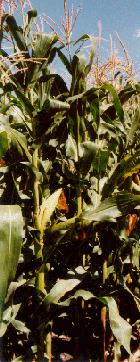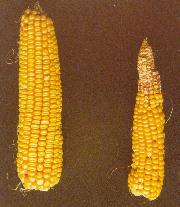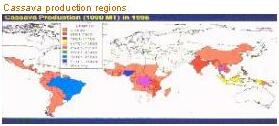

Research on environmental responses
in crop plants
Tim Setter's lab
Cornell University

 Drought and cell division in maize kernels: hormones and sugar sensing
Drought and cell division in maize kernels: hormones and sugar sensing
 Potato and global climate change: elevated CO2 and heat stress
Potato and global climate change: elevated CO2 and heat stress

 Drought and leaf cell growth in cassava
Drought and leaf cell growth in cassava
Mechanisms by which
water deficit alters cell division
in developing maize kernels

Plants have evolved mechanisms to adjust their reproductive development upon exposure to water deficit and other stresses. In genotypes adapted to natural habitats, production of viable embryos may take precedence over the overall quantity of storage-material synthesis. However, such mechanisms may not be well suited to provide optimum crop performance.
Genotypes are needed that have low rates of floral and grain abortion in response to such environments. In the maize system we are studying, apical kernels are selectively aborted in response to whole-plant environmental stress, while on the same plant, the basal kernels grow unhindered to full size. This preferential abortion, which involves decreased cell
division in apical regions of maize ears, may be a remnant of
mechanisms which evolved to limit the number of seeds per plant.
In genotypes used solely for grain production, such mechanisms,
which restrict storage-material synthesis in sink organs, are
usually undesirable and may be responsible for decreased crop
productivity.
This preferential abortion, which involves decreased cell
division in apical regions of maize ears, may be a remnant of
mechanisms which evolved to limit the number of seeds per plant.
In genotypes used solely for grain production, such mechanisms,
which restrict storage-material synthesis in sink organs, are
usually undesirable and may be responsible for decreased crop
productivity.
In the most productive genotypes, this genetically-programmed process of selective abortion appears to respond to whole-plant cues such that it tends to improve the balance between photosynthetic production of sugars and sink-organ carbohydrate utilization. However, the response is complex, and in many circumstances, such as where there is an interplay between multiple stresses, or in early phases of a breeding program, the extent of abortion is excessive, thereby limiting grain yield. The challenge, then, is to understand the underlying mechanisms so that they can be harnessed and efficiently manipulated through appropriate crop cultural practices and genetic improvement.
Our recent findings (see publications list) have indicated that reproductive abortion in stress environments involves the plant hormone abscisic acid (ABA) and inadequate sugar flux into growing tissues. Although ABA induces numerous drought tolerance responses in leaves and roots, its accumulation in floral and grain tissues during circumstances conferring low sugar supplies can abort reproductive organs and reduce yield.
Cell division and primordium initiation in meristems are processes among the most sensitive to drought and other environmental stresses. Furthermore, effects on cell division have consequences that extend beyond the treatment period, because cell division occurs early in the development of determinate organs and it plays critical roles in the morphological differentiation of meristems.
 In our current
work we are evaluating the postulated
involvement of plant hormones (ABA, cytokinins, IAA), sugar, cell division, and other processes in
stress response by using the method of cDNA microarray to determine the mRNA levels of gene products representing the spectrum of response pathways
in plants. To test postulated production of signals generated in
the post-phloem pathway of maize kernels, levels of signaling
molecules are being localized and related to stress-induced loss
of kernel set.
In our current
work we are evaluating the postulated
involvement of plant hormones (ABA, cytokinins, IAA), sugar, cell division, and other processes in
stress response by using the method of cDNA microarray to determine the mRNA levels of gene products representing the spectrum of response pathways
in plants. To test postulated production of signals generated in
the post-phloem pathway of maize kernels, levels of signaling
molecules are being localized and related to stress-induced loss
of kernel set.
The long-range goal of our studies is to understand the cellular and physiological bases for diminished performance of plants subjected to drought and other environmental stresses. We anticipate that this will lead, in turn, to the identification of genetically controlled systems which can be manipulated to improve performance of grain crops during environmental stress. Such work has the potential to increase the stability of yield performance with respect to unpredictable weather patterns, and thereby contribute to a sustainable agriculture.
Potato Response to Future
Global Climate Change:
Elevated Carbon Dioxide and Temperature

Global climate change is predicted to elevate atmospheric CO2 concentration and increase the frequency of high temperature episodes (climate assessment). Such changes will alter the zones of crop adaptation and may require modification of current crops. Hence, an understanding of plant response to such environments is important in meeting the challenges of the new century.
Plants grown with elevated atmospheric CO2 initially increase their photosynthetic rate. However, after several days of exposure to elevated CO2, many plants acclimate and photosynthetic rates become only marginally higher or even lower than before. It appears that a sustained stimulation of photosynthesis and growth in response to elevated atmospheric CO2 requires an increase of sink organ development to utilize and store additional photosynthate. Without sufficient sink capacity, photosynthate can feed back such that source capacity is brought back into balance with sink capacity. Thus, the relative magnitude of source and sink activities is an important determinant of crop yield in future climates.
In general, plants are able to adjust their development of sink organs in response to altered photosynthetic rates. Elevated CO2 during the reproductive stage can increase reproductive-organ success by increasing the number and size of organs initiated, decreasing the extent of organ abortion, and increasing the amount of storage-material accumulated. But little is known about the factors that limit the capacity for up-regulation of sink capacity and the regulatory mechanisms that are at work.
High temperature limits potato yield in at least in two ways: by a general dysfunction of plant metabolism resulting from heat stress, and via temperature-modulated development that reduces partitioning of assimilates to the tubers in favor of leaves and stems. Heat stress is believed to decrease plant growth due to inhibition of photosynthetic rate. Thus, it has been proposed that elevated CO2 treatment, which is expected to enhance photoassimilate supply, may alleviate the effect of heat stress on tuber growth.

We are investigating the response of potato to various CO2, light and temperature treatments imposed at discrete stages of tuber development. Our findings indicate that elevated CO2 substantially increases the rate of photosynthetic carbon assimilation, apparently avoiding feedback effects by upregulating sink development.
To evaluate how sink capacity was modulated, we have measured cell numbers, cell size, and extent of endoreduplication with flow cytometry. These studies have shown that tuber cell division is the primary mechanism by which sink capacity is affected whereas average cell size, endoreduplication, and biomass per cell (primarily starch) are not enhanced. We are also studying cambial glucose and sucrose concentrations, and activities of several enzymes of sugar metabolism.
We have used shade as an additional test of the effects of altered photosynthate status. Shade altered several tuber properties in the reverse direction compared to those for elevated CO2. It decreased cambial-zone tuber glucose levels and soluble-invertase activity, and decreased tuber production due to decreased cell proliferation.
 Our studies of heat tolerance have indicated that, in comparison with normal temperature (25/18° C, day/night), high temperature
(35/25° C) decreases whole-plant
growth, while percentage enhancement by elevated CO2 is considerably greater at high than at normal temperature. The tuber initiation phase is especially vulnerable to high temperature, and this correlated with the inhibition of tuber cell production.
Our studies of heat tolerance have indicated that, in comparison with normal temperature (25/18° C, day/night), high temperature
(35/25° C) decreases whole-plant
growth, while percentage enhancement by elevated CO2 is considerably greater at high than at normal temperature. The tuber initiation phase is especially vulnerable to high temperature, and this correlated with the inhibition of tuber cell production.
We conclude that much of the growth response to climate variables is due to modulation of tuber cell division. Such well-tuned regulation of sink capacity in response to photosynthetic environment provides potato with an ability to avoid feedback inhibition of photosynthesis which has been observed in other species. However, potato sensitivity to high temperature may limit its performance in future climates. This property deserves future research attention.
Mechanisms of leaf growth
response to short-term drought
in cassava
 Cassava (Manihot
esculenta, Crantz; Mandioca, Manioc, Yuca, Tapioca), which produces a starchy tuberous root,
is one of the world’s most important staple food crops. It is
ranked as the sixth most important source of calories in the
human diet worldwide, and is particularly important to
subsistence farmers utilizing low-fertility and stress-prone
soils. About 50% is produced in Africa, 30% in Asia, and 20% in
the Americas. Although it is grown in a wide range of climates
(between 30o N and 30o S latitude), from
drought-prone to well-watered regions, it is commonly cultivated
in areas receiving less than 800 mm rainfall per year with a dry
season of 4 to 6 months, where tolerance to water deficit is an
important attribute.
Cassava (Manihot
esculenta, Crantz; Mandioca, Manioc, Yuca, Tapioca), which produces a starchy tuberous root,
is one of the world’s most important staple food crops. It is
ranked as the sixth most important source of calories in the
human diet worldwide, and is particularly important to
subsistence farmers utilizing low-fertility and stress-prone
soils. About 50% is produced in Africa, 30% in Asia, and 20% in
the Americas. Although it is grown in a wide range of climates
(between 30o N and 30o S latitude), from
drought-prone to well-watered regions, it is commonly cultivated
in areas receiving less than 800 mm rainfall per year with a dry
season of 4 to 6 months, where tolerance to water deficit is an
important attribute.
 To improve our understanding of cassava's behavior in response to drought episodes, we have examined cassava genotypes from five
climatic zones of Brazil. We subjected them to short-term water
deficit and recovery treatments during the vegetative growth
stage. Plants responded dramatically to the initial phase of
water deprivation by halting leaf growth and closing stomata,
thereby limiting further water loss. Recovery of transpiration
after rewatering was also rapid, but leaf growth in youngest
leaves was delayed and did not completely recover.
Correspondingly, levels of the stress hormone, abscisic acid
(ABA), increased rapidly during stress and declined rapidly
during recovery
(see publications list).
Our examination of leaf growth components in leaves at all
stages of early development revealed that water deficit decreased
leaf area growth due to inhibition of both cell expansion and
cell division, with about equal sensitivity. In addition, the
rate of new leaf production decreased during stress, accounting
for about 40% of the leaf area reduction due to the stress. The
extent to which the three component processes - cell expansion,
cell division, and leaf initiation - were inhibited in a
particular leaf nodal position corresponded with that leaf's
concurrent developmental stage during the 8-day stress. All
three processes recovered, partially, after relief of stress. We
did not find evidence of osmotic adjustment.
To improve our understanding of cassava's behavior in response to drought episodes, we have examined cassava genotypes from five
climatic zones of Brazil. We subjected them to short-term water
deficit and recovery treatments during the vegetative growth
stage. Plants responded dramatically to the initial phase of
water deprivation by halting leaf growth and closing stomata,
thereby limiting further water loss. Recovery of transpiration
after rewatering was also rapid, but leaf growth in youngest
leaves was delayed and did not completely recover.
Correspondingly, levels of the stress hormone, abscisic acid
(ABA), increased rapidly during stress and declined rapidly
during recovery
(see publications list).
Our examination of leaf growth components in leaves at all
stages of early development revealed that water deficit decreased
leaf area growth due to inhibition of both cell expansion and
cell division, with about equal sensitivity. In addition, the
rate of new leaf production decreased during stress, accounting
for about 40% of the leaf area reduction due to the stress. The
extent to which the three component processes - cell expansion,
cell division, and leaf initiation - were inhibited in a
particular leaf nodal position corresponded with that leaf's
concurrent developmental stage during the 8-day stress. All
three processes recovered, partially, after relief of stress. We
did not find evidence of osmotic adjustment.
We conclude that cassava responds to water deficit by rapidly closing stomata, thus maintaining high water potential with minimal osmotic adjustment. It halts leaf growth during a stress episode, but rapidly recovers after rainfall resumes. This behavior contrasts with that of many other species, which respond to water deficit episodes by maintaining partially open stomata, and modest rates of photosynthesis while allowing tissue water potential to progressively decline. Thus, cassava may have a drought response appropriate for environments with cycles of intermittent or seasonal drought, followed by recovery of water status, when the bulk of growth occurs. Cassava's ability to rapidly accumulate ABA and to halt leaf area growth during dry cycles and to rapidly recover after rewatering is consistent with high productivity in such environments.